CHCDIS001 Assignment: Skills Development using Strengths Approach
VerifiedAdded on 2023/06/07
|48
|11003
|235
Homework Assignment
AI Summary
This document is a learner workbook assignment for the CHCDIS001 unit, focusing on contributing to ongoing skills development using a strengths-based approach. The assignment, developed by Hope Training College of Australia, outlines assessment instructions, plagiarism and collusion policies, and competency outcomes. It details assessment requirements, including direct observation, product-based methods, and third-party evidence. The workbook includes candidate details, declaration, and observation/demonstration guidelines. The assessment emphasizes active participation and requires learners to demonstrate competency through various activities. The document provides a comprehensive guide to the assessment process, ensuring learners understand the requirements for successful completion of the unit.
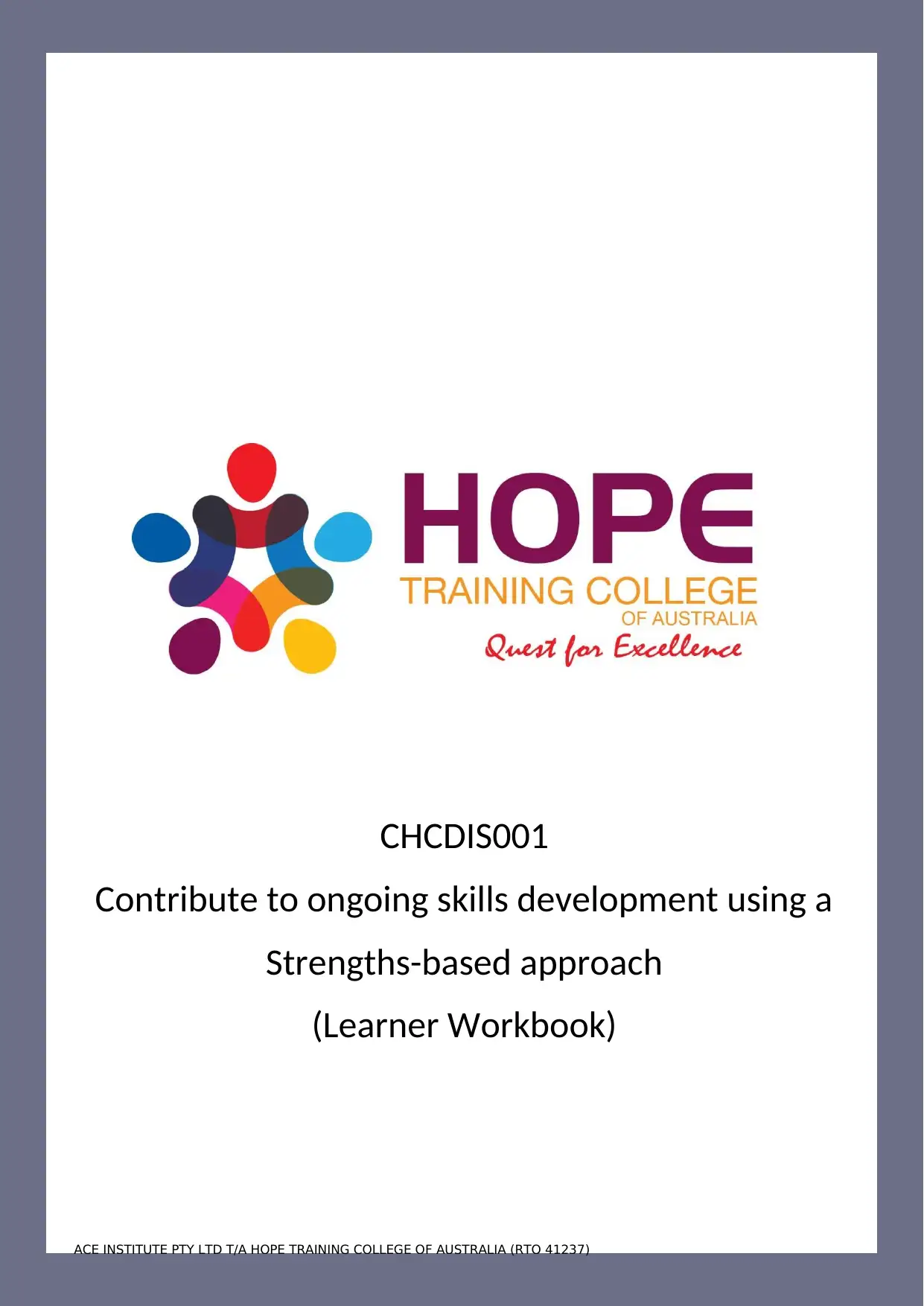
CHCDIS001 CONTRIBUTE TO ONGOING SKILLS DEVELOPMENT USING STRENGHTS APPROACH
Page 1 of 48
DOCUMENT CODE: 118, VERSION: APRIL 2018
AUTHORISED BY CEO
ACE INSTITUTE PTY LTD T/A HOPE TRAINING COLLEGE OF AUSTRALIA (RTO 41237)
CHCDIS001
Contribute to ongoing skills development using a
Strengths-based approach
(Learner Workbook)
Page 1 of 48
DOCUMENT CODE: 118, VERSION: APRIL 2018
AUTHORISED BY CEO
ACE INSTITUTE PTY LTD T/A HOPE TRAINING COLLEGE OF AUSTRALIA (RTO 41237)
CHCDIS001
Contribute to ongoing skills development using a
Strengths-based approach
(Learner Workbook)
Paraphrase This Document
Need a fresh take? Get an instant paraphrase of this document with our AI Paraphraser

CHCDIS001 CONTRIBUTE TO ONGOING SKILLS DEVELOPMENT USING STRENGHTS APPROACH
Page 2 of 48
DOCUMENT CODE: 118, VERSION: APRIL 2018
AUTHORISED BY CEO
ACE INSTITUTE PTY LTD T/A HOPE TRAINING COLLEGE OF AUSTRALIA (RTO 41237)
Page 2 of 48
DOCUMENT CODE: 118, VERSION: APRIL 2018
AUTHORISED BY CEO
ACE INSTITUTE PTY LTD T/A HOPE TRAINING COLLEGE OF AUSTRALIA (RTO 41237)
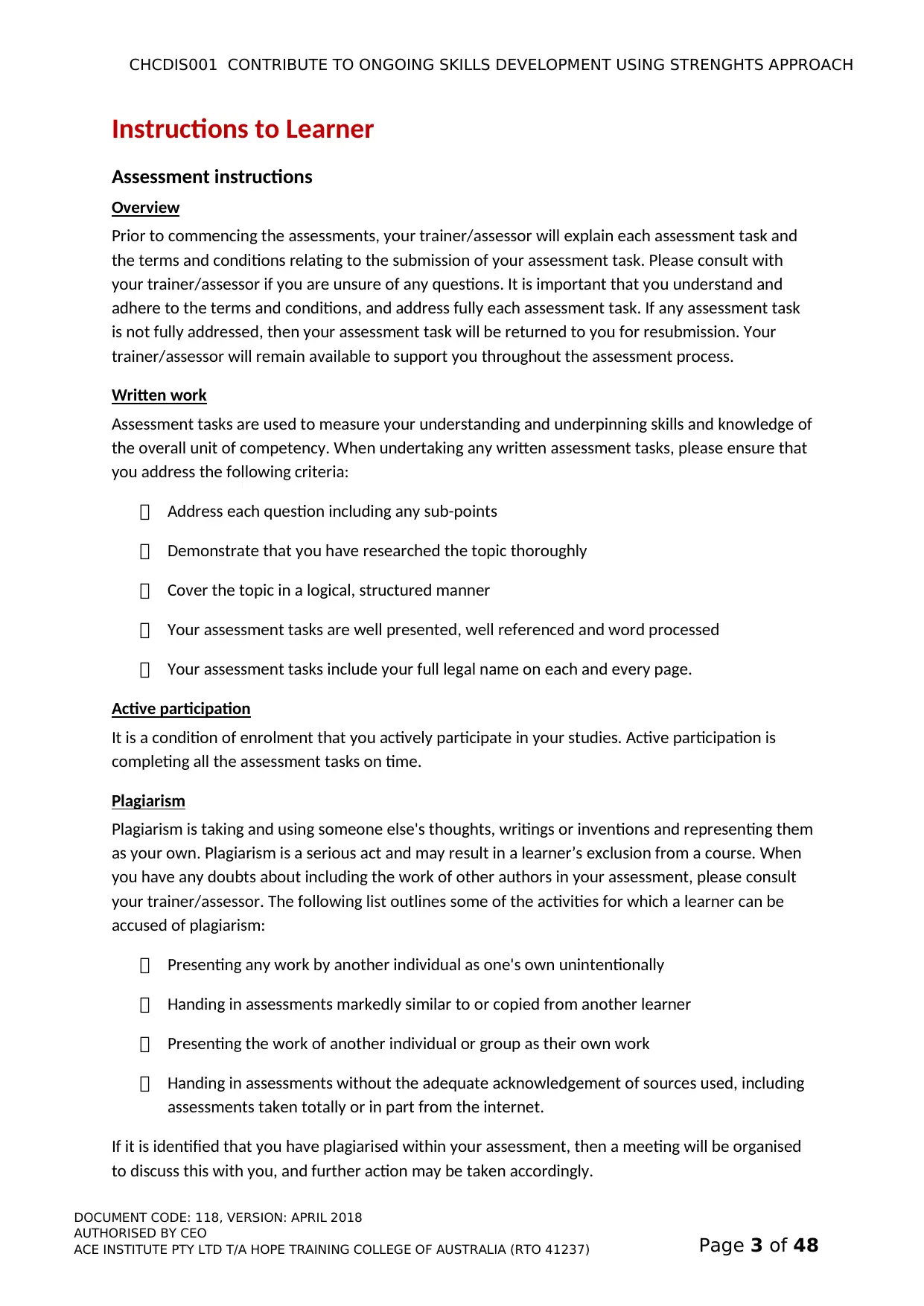
CHCDIS001 CONTRIBUTE TO ONGOING SKILLS DEVELOPMENT USING STRENGHTS APPROACH
Page 3 of 48
DOCUMENT CODE: 118, VERSION: APRIL 2018
AUTHORISED BY CEO
ACE INSTITUTE PTY LTD T/A HOPE TRAINING COLLEGE OF AUSTRALIA (RTO 41237)
Instructions to Learner
Assessment instructions
Overview
Prior to commencing the assessments, your trainer/assessor will explain each assessment task and
the terms and conditions relating to the submission of your assessment task. Please consult with
your trainer/assessor if you are unsure of any questions. It is important that you understand and
adhere to the terms and conditions, and address fully each assessment task. If any assessment task
is not fully addressed, then your assessment task will be returned to you for resubmission. Your
trainer/assessor will remain available to support you throughout the assessment process.
Written work
Assessment tasks are used to measure your understanding and underpinning skills and knowledge of
the overall unit of competency. When undertaking any written assessment tasks, please ensure that
you address the following criteria:
Address each question including any sub-points
Demonstrate that you have researched the topic thoroughly
Cover the topic in a logical, structured manner
Your assessment tasks are well presented, well referenced and word processed
Your assessment tasks include your full legal name on each and every page.
Active participation
It is a condition of enrolment that you actively participate in your studies. Active participation is
completing all the assessment tasks on time.
Plagiarism
Plagiarism is taking and using someone else's thoughts, writings or inventions and representing them
as your own. Plagiarism is a serious act and may result in a learner’s exclusion from a course. When
you have any doubts about including the work of other authors in your assessment, please consult
your trainer/assessor. The following list outlines some of the activities for which a learner can be
accused of plagiarism:
Presenting any work by another individual as one's own unintentionally
Handing in assessments markedly similar to or copied from another learner
Presenting the work of another individual or group as their own work
Handing in assessments without the adequate acknowledgement of sources used, including
assessments taken totally or in part from the internet.
If it is identified that you have plagiarised within your assessment, then a meeting will be organised
to discuss this with you, and further action may be taken accordingly.
Page 3 of 48
DOCUMENT CODE: 118, VERSION: APRIL 2018
AUTHORISED BY CEO
ACE INSTITUTE PTY LTD T/A HOPE TRAINING COLLEGE OF AUSTRALIA (RTO 41237)
Instructions to Learner
Assessment instructions
Overview
Prior to commencing the assessments, your trainer/assessor will explain each assessment task and
the terms and conditions relating to the submission of your assessment task. Please consult with
your trainer/assessor if you are unsure of any questions. It is important that you understand and
adhere to the terms and conditions, and address fully each assessment task. If any assessment task
is not fully addressed, then your assessment task will be returned to you for resubmission. Your
trainer/assessor will remain available to support you throughout the assessment process.
Written work
Assessment tasks are used to measure your understanding and underpinning skills and knowledge of
the overall unit of competency. When undertaking any written assessment tasks, please ensure that
you address the following criteria:
Address each question including any sub-points
Demonstrate that you have researched the topic thoroughly
Cover the topic in a logical, structured manner
Your assessment tasks are well presented, well referenced and word processed
Your assessment tasks include your full legal name on each and every page.
Active participation
It is a condition of enrolment that you actively participate in your studies. Active participation is
completing all the assessment tasks on time.
Plagiarism
Plagiarism is taking and using someone else's thoughts, writings or inventions and representing them
as your own. Plagiarism is a serious act and may result in a learner’s exclusion from a course. When
you have any doubts about including the work of other authors in your assessment, please consult
your trainer/assessor. The following list outlines some of the activities for which a learner can be
accused of plagiarism:
Presenting any work by another individual as one's own unintentionally
Handing in assessments markedly similar to or copied from another learner
Presenting the work of another individual or group as their own work
Handing in assessments without the adequate acknowledgement of sources used, including
assessments taken totally or in part from the internet.
If it is identified that you have plagiarised within your assessment, then a meeting will be organised
to discuss this with you, and further action may be taken accordingly.
⊘ This is a preview!⊘
Do you want full access?
Subscribe today to unlock all pages.

Trusted by 1+ million students worldwide
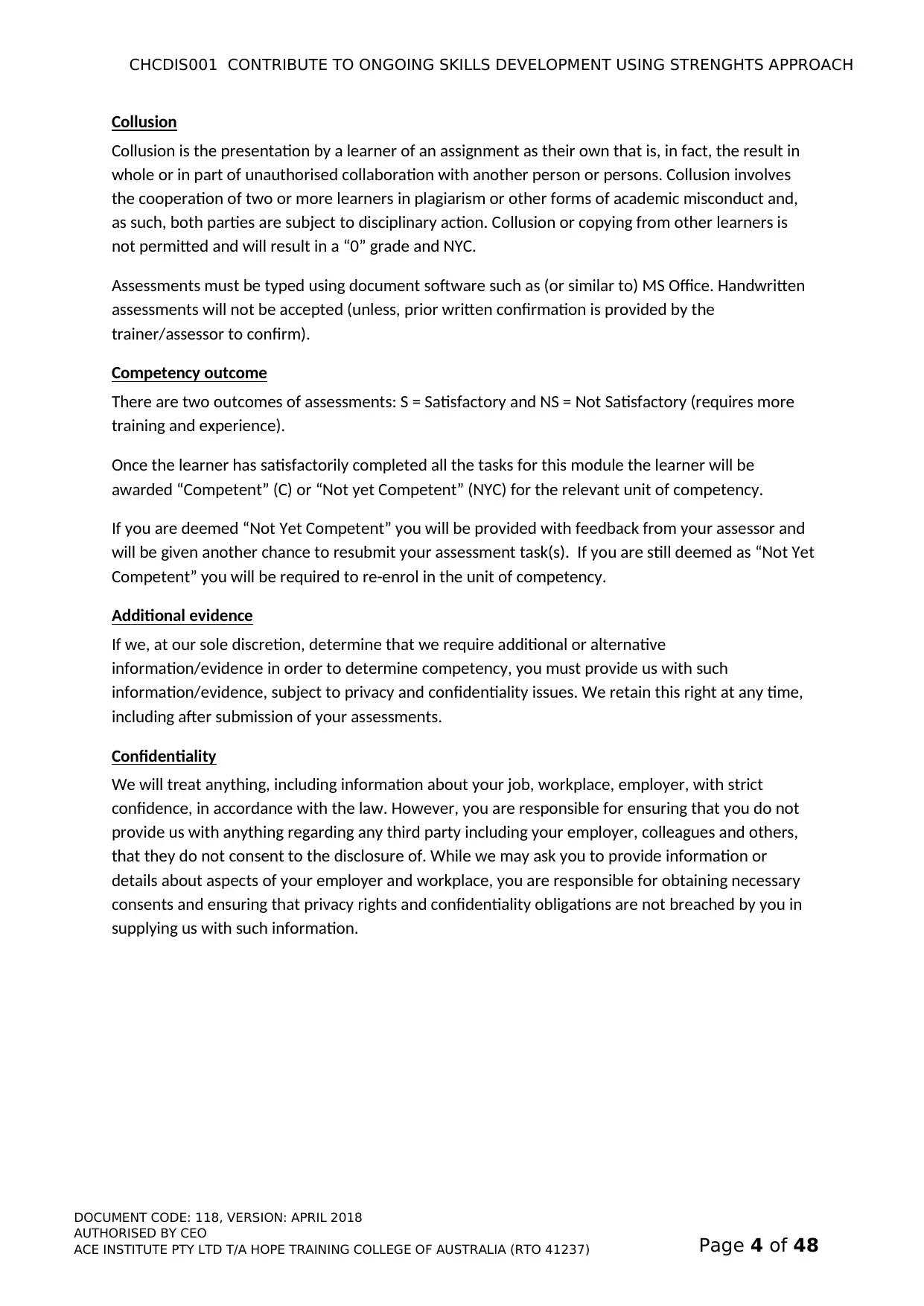
CHCDIS001 CONTRIBUTE TO ONGOING SKILLS DEVELOPMENT USING STRENGHTS APPROACH
Page 4 of 48
DOCUMENT CODE: 118, VERSION: APRIL 2018
AUTHORISED BY CEO
ACE INSTITUTE PTY LTD T/A HOPE TRAINING COLLEGE OF AUSTRALIA (RTO 41237)
Collusion
Collusion is the presentation by a learner of an assignment as their own that is, in fact, the result in
whole or in part of unauthorised collaboration with another person or persons. Collusion involves
the cooperation of two or more learners in plagiarism or other forms of academic misconduct and,
as such, both parties are subject to disciplinary action. Collusion or copying from other learners is
not permitted and will result in a “0” grade and NYC.
Assessments must be typed using document software such as (or similar to) MS Office. Handwritten
assessments will not be accepted (unless, prior written confirmation is provided by the
trainer/assessor to confirm).
Competency outcome
There are two outcomes of assessments: S = Satisfactory and NS = Not Satisfactory (requires more
training and experience).
Once the learner has satisfactorily completed all the tasks for this module the learner will be
awarded “Competent” (C) or “Not yet Competent” (NYC) for the relevant unit of competency.
If you are deemed “Not Yet Competent” you will be provided with feedback from your assessor and
will be given another chance to resubmit your assessment task(s). If you are still deemed as “Not Yet
Competent” you will be required to re-enrol in the unit of competency.
Additional evidence
If we, at our sole discretion, determine that we require additional or alternative
information/evidence in order to determine competency, you must provide us with such
information/evidence, subject to privacy and confidentiality issues. We retain this right at any time,
including after submission of your assessments.
Confidentiality
We will treat anything, including information about your job, workplace, employer, with strict
confidence, in accordance with the law. However, you are responsible for ensuring that you do not
provide us with anything regarding any third party including your employer, colleagues and others,
that they do not consent to the disclosure of. While we may ask you to provide information or
details about aspects of your employer and workplace, you are responsible for obtaining necessary
consents and ensuring that privacy rights and confidentiality obligations are not breached by you in
supplying us with such information.
Page 4 of 48
DOCUMENT CODE: 118, VERSION: APRIL 2018
AUTHORISED BY CEO
ACE INSTITUTE PTY LTD T/A HOPE TRAINING COLLEGE OF AUSTRALIA (RTO 41237)
Collusion
Collusion is the presentation by a learner of an assignment as their own that is, in fact, the result in
whole or in part of unauthorised collaboration with another person or persons. Collusion involves
the cooperation of two or more learners in plagiarism or other forms of academic misconduct and,
as such, both parties are subject to disciplinary action. Collusion or copying from other learners is
not permitted and will result in a “0” grade and NYC.
Assessments must be typed using document software such as (or similar to) MS Office. Handwritten
assessments will not be accepted (unless, prior written confirmation is provided by the
trainer/assessor to confirm).
Competency outcome
There are two outcomes of assessments: S = Satisfactory and NS = Not Satisfactory (requires more
training and experience).
Once the learner has satisfactorily completed all the tasks for this module the learner will be
awarded “Competent” (C) or “Not yet Competent” (NYC) for the relevant unit of competency.
If you are deemed “Not Yet Competent” you will be provided with feedback from your assessor and
will be given another chance to resubmit your assessment task(s). If you are still deemed as “Not Yet
Competent” you will be required to re-enrol in the unit of competency.
Additional evidence
If we, at our sole discretion, determine that we require additional or alternative
information/evidence in order to determine competency, you must provide us with such
information/evidence, subject to privacy and confidentiality issues. We retain this right at any time,
including after submission of your assessments.
Confidentiality
We will treat anything, including information about your job, workplace, employer, with strict
confidence, in accordance with the law. However, you are responsible for ensuring that you do not
provide us with anything regarding any third party including your employer, colleagues and others,
that they do not consent to the disclosure of. While we may ask you to provide information or
details about aspects of your employer and workplace, you are responsible for obtaining necessary
consents and ensuring that privacy rights and confidentiality obligations are not breached by you in
supplying us with such information.
Paraphrase This Document
Need a fresh take? Get an instant paraphrase of this document with our AI Paraphraser
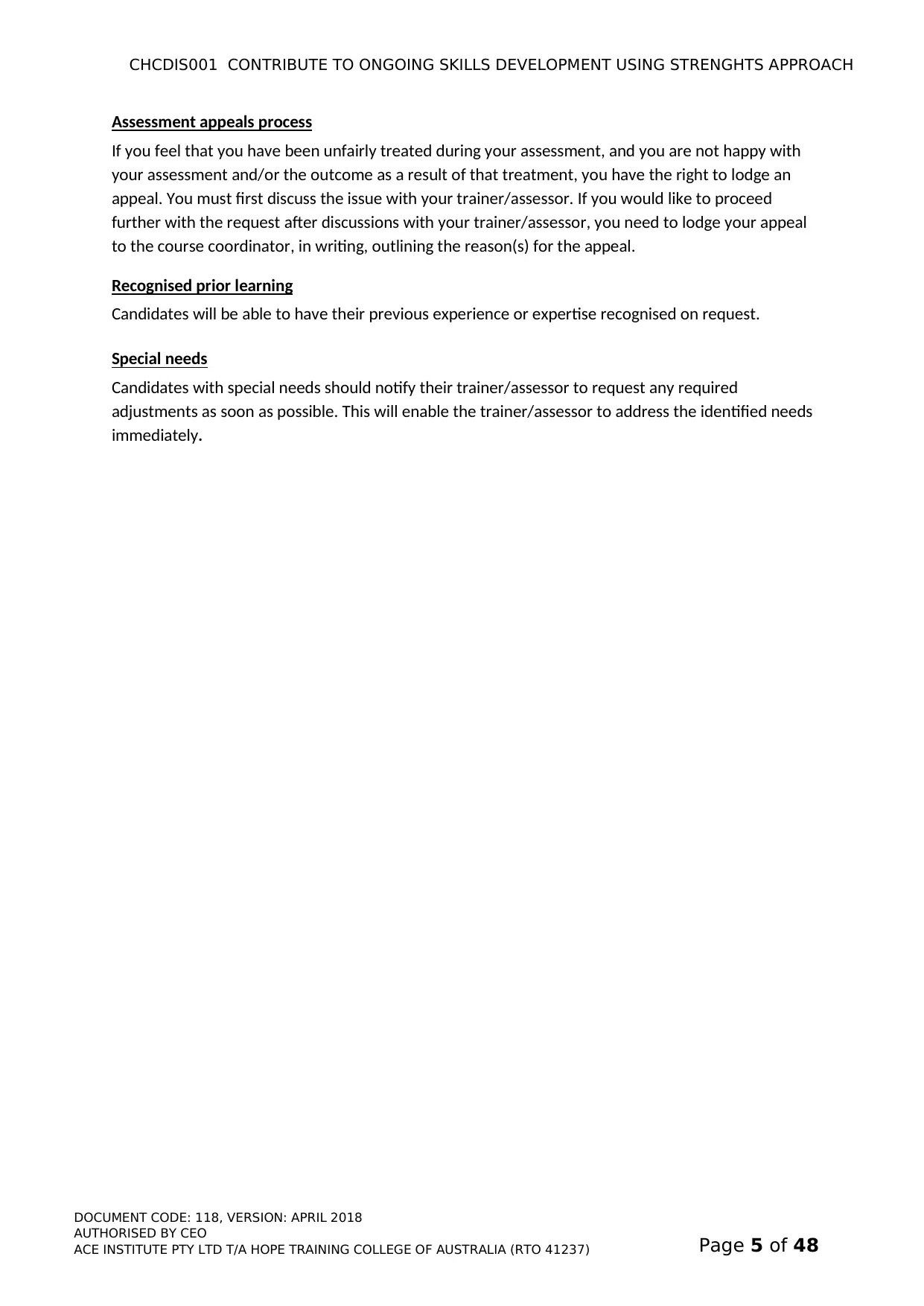
CHCDIS001 CONTRIBUTE TO ONGOING SKILLS DEVELOPMENT USING STRENGHTS APPROACH
Page 5 of 48
DOCUMENT CODE: 118, VERSION: APRIL 2018
AUTHORISED BY CEO
ACE INSTITUTE PTY LTD T/A HOPE TRAINING COLLEGE OF AUSTRALIA (RTO 41237)
Assessment appeals process
If you feel that you have been unfairly treated during your assessment, and you are not happy with
your assessment and/or the outcome as a result of that treatment, you have the right to lodge an
appeal. You must first discuss the issue with your trainer/assessor. If you would like to proceed
further with the request after discussions with your trainer/assessor, you need to lodge your appeal
to the course coordinator, in writing, outlining the reason(s) for the appeal.
Recognised prior learning
Candidates will be able to have their previous experience or expertise recognised on request.
Special needs
Candidates with special needs should notify their trainer/assessor to request any required
adjustments as soon as possible. This will enable the trainer/assessor to address the identified needs
immediately .
Page 5 of 48
DOCUMENT CODE: 118, VERSION: APRIL 2018
AUTHORISED BY CEO
ACE INSTITUTE PTY LTD T/A HOPE TRAINING COLLEGE OF AUSTRALIA (RTO 41237)
Assessment appeals process
If you feel that you have been unfairly treated during your assessment, and you are not happy with
your assessment and/or the outcome as a result of that treatment, you have the right to lodge an
appeal. You must first discuss the issue with your trainer/assessor. If you would like to proceed
further with the request after discussions with your trainer/assessor, you need to lodge your appeal
to the course coordinator, in writing, outlining the reason(s) for the appeal.
Recognised prior learning
Candidates will be able to have their previous experience or expertise recognised on request.
Special needs
Candidates with special needs should notify their trainer/assessor to request any required
adjustments as soon as possible. This will enable the trainer/assessor to address the identified needs
immediately .
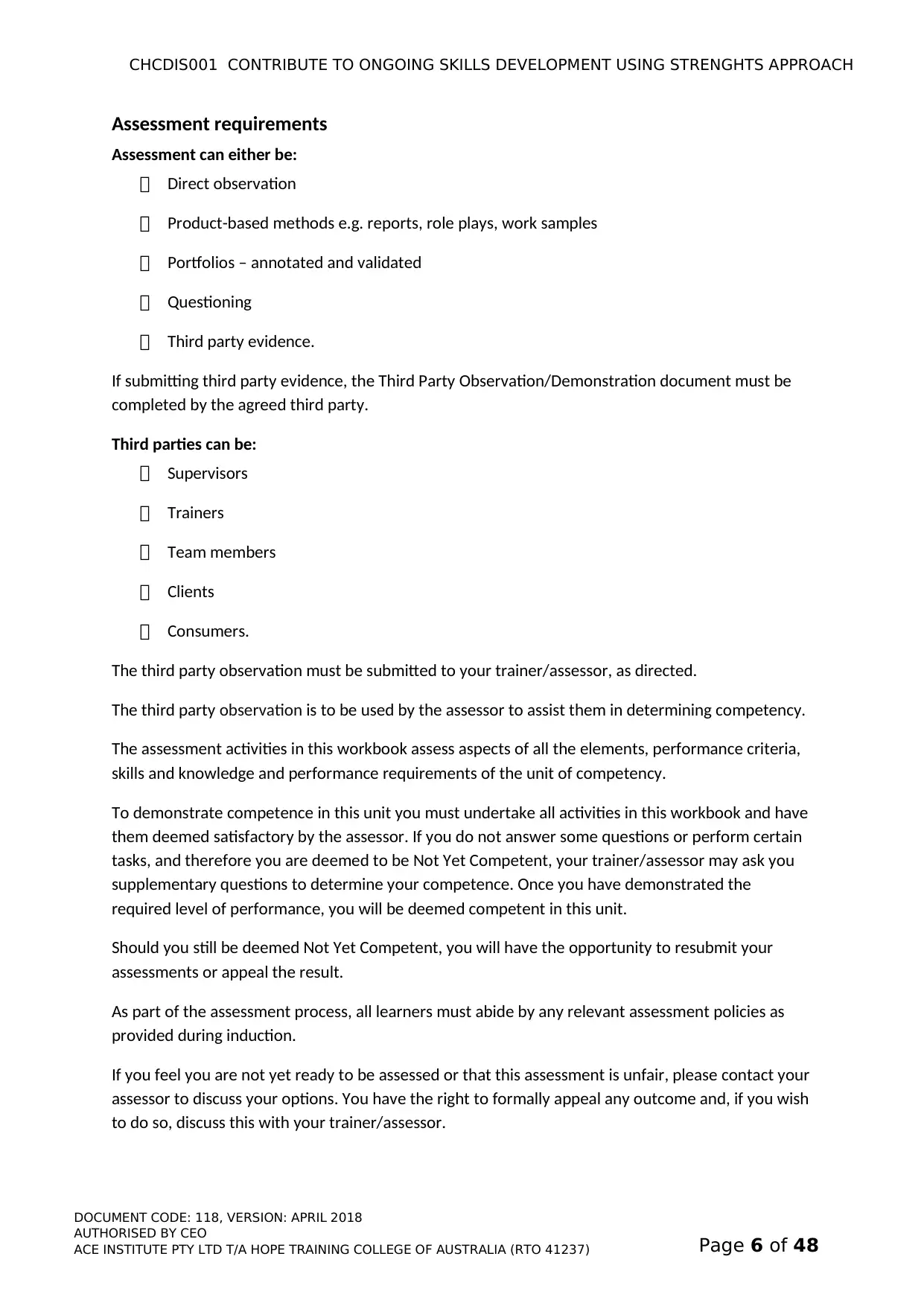
CHCDIS001 CONTRIBUTE TO ONGOING SKILLS DEVELOPMENT USING STRENGHTS APPROACH
Page 6 of 48
DOCUMENT CODE: 118, VERSION: APRIL 2018
AUTHORISED BY CEO
ACE INSTITUTE PTY LTD T/A HOPE TRAINING COLLEGE OF AUSTRALIA (RTO 41237)
Assessment requirements
Assessment can either be:
Direct observation
Product-based methods e.g. reports, role plays, work samples
Portfolios – annotated and validated
Questioning
Third party evidence.
If submitting third party evidence, the Third Party Observation/Demonstration document must be
completed by the agreed third party.
Third parties can be:
Supervisors
Trainers
Team members
Clients
Consumers.
The third party observation must be submitted to your trainer/assessor, as directed.
The third party observation is to be used by the assessor to assist them in determining competency.
The assessment activities in this workbook assess aspects of all the elements, performance criteria,
skills and knowledge and performance requirements of the unit of competency.
To demonstrate competence in this unit you must undertake all activities in this workbook and have
them deemed satisfactory by the assessor. If you do not answer some questions or perform certain
tasks, and therefore you are deemed to be Not Yet Competent, your trainer/assessor may ask you
supplementary questions to determine your competence. Once you have demonstrated the
required level of performance, you will be deemed competent in this unit.
Should you still be deemed Not Yet Competent, you will have the opportunity to resubmit your
assessments or appeal the result.
As part of the assessment process, all learners must abide by any relevant assessment policies as
provided during induction.
If you feel you are not yet ready to be assessed or that this assessment is unfair, please contact your
assessor to discuss your options. You have the right to formally appeal any outcome and, if you wish
to do so, discuss this with your trainer/assessor.
Page 6 of 48
DOCUMENT CODE: 118, VERSION: APRIL 2018
AUTHORISED BY CEO
ACE INSTITUTE PTY LTD T/A HOPE TRAINING COLLEGE OF AUSTRALIA (RTO 41237)
Assessment requirements
Assessment can either be:
Direct observation
Product-based methods e.g. reports, role plays, work samples
Portfolios – annotated and validated
Questioning
Third party evidence.
If submitting third party evidence, the Third Party Observation/Demonstration document must be
completed by the agreed third party.
Third parties can be:
Supervisors
Trainers
Team members
Clients
Consumers.
The third party observation must be submitted to your trainer/assessor, as directed.
The third party observation is to be used by the assessor to assist them in determining competency.
The assessment activities in this workbook assess aspects of all the elements, performance criteria,
skills and knowledge and performance requirements of the unit of competency.
To demonstrate competence in this unit you must undertake all activities in this workbook and have
them deemed satisfactory by the assessor. If you do not answer some questions or perform certain
tasks, and therefore you are deemed to be Not Yet Competent, your trainer/assessor may ask you
supplementary questions to determine your competence. Once you have demonstrated the
required level of performance, you will be deemed competent in this unit.
Should you still be deemed Not Yet Competent, you will have the opportunity to resubmit your
assessments or appeal the result.
As part of the assessment process, all learners must abide by any relevant assessment policies as
provided during induction.
If you feel you are not yet ready to be assessed or that this assessment is unfair, please contact your
assessor to discuss your options. You have the right to formally appeal any outcome and, if you wish
to do so, discuss this with your trainer/assessor.
⊘ This is a preview!⊘
Do you want full access?
Subscribe today to unlock all pages.

Trusted by 1+ million students worldwide
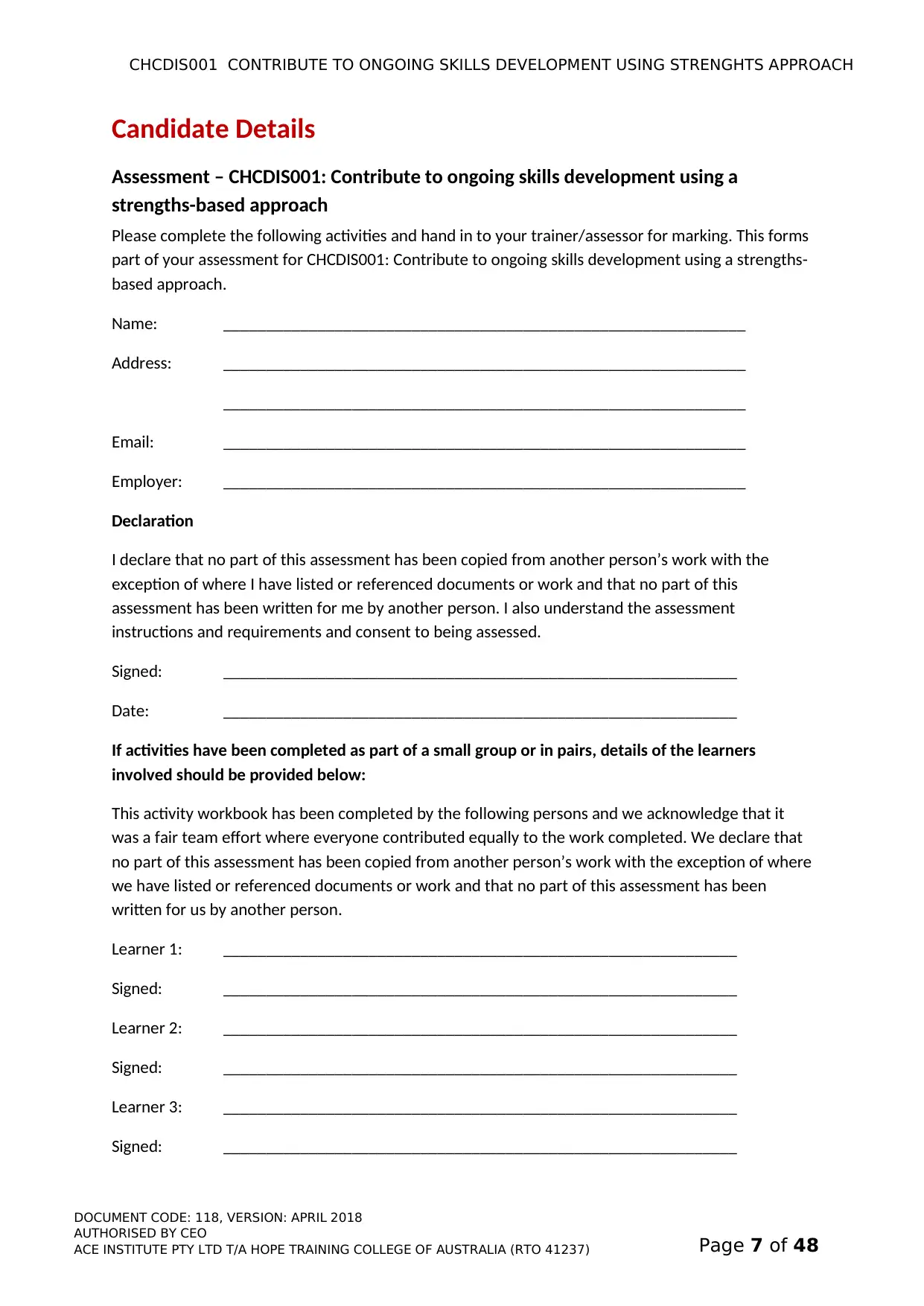
CHCDIS001 CONTRIBUTE TO ONGOING SKILLS DEVELOPMENT USING STRENGHTS APPROACH
Page 7 of 48
DOCUMENT CODE: 118, VERSION: APRIL 2018
AUTHORISED BY CEO
ACE INSTITUTE PTY LTD T/A HOPE TRAINING COLLEGE OF AUSTRALIA (RTO 41237)
Candidate Details
Assessment – CHCDIS001: Contribute to ongoing skills development using a
strengths-based approach
Please complete the following activities and hand in to your trainer/assessor for marking. This forms
part of your assessment for CHCDIS001: Contribute to ongoing skills development using a strengths-
based approach.
Name: _____________________________________________________________
Address: _____________________________________________________________
_____________________________________________________________
Email: _____________________________________________________________
Employer: _____________________________________________________________
Declaration
I declare that no part of this assessment has been copied from another person’s work with the
exception of where I have listed or referenced documents or work and that no part of this
assessment has been written for me by another person. I also understand the assessment
instructions and requirements and consent to being assessed.
Signed: ____________________________________________________________
Date: ____________________________________________________________
If activities have been completed as part of a small group or in pairs, details of the learners
involved should be provided below:
This activity workbook has been completed by the following persons and we acknowledge that it
was a fair team effort where everyone contributed equally to the work completed. We declare that
no part of this assessment has been copied from another person’s work with the exception of where
we have listed or referenced documents or work and that no part of this assessment has been
written for us by another person.
Learner 1: ____________________________________________________________
Signed: ____________________________________________________________
Learner 2: ____________________________________________________________
Signed: ____________________________________________________________
Learner 3: ____________________________________________________________
Signed: ____________________________________________________________
Page 7 of 48
DOCUMENT CODE: 118, VERSION: APRIL 2018
AUTHORISED BY CEO
ACE INSTITUTE PTY LTD T/A HOPE TRAINING COLLEGE OF AUSTRALIA (RTO 41237)
Candidate Details
Assessment – CHCDIS001: Contribute to ongoing skills development using a
strengths-based approach
Please complete the following activities and hand in to your trainer/assessor for marking. This forms
part of your assessment for CHCDIS001: Contribute to ongoing skills development using a strengths-
based approach.
Name: _____________________________________________________________
Address: _____________________________________________________________
_____________________________________________________________
Email: _____________________________________________________________
Employer: _____________________________________________________________
Declaration
I declare that no part of this assessment has been copied from another person’s work with the
exception of where I have listed or referenced documents or work and that no part of this
assessment has been written for me by another person. I also understand the assessment
instructions and requirements and consent to being assessed.
Signed: ____________________________________________________________
Date: ____________________________________________________________
If activities have been completed as part of a small group or in pairs, details of the learners
involved should be provided below:
This activity workbook has been completed by the following persons and we acknowledge that it
was a fair team effort where everyone contributed equally to the work completed. We declare that
no part of this assessment has been copied from another person’s work with the exception of where
we have listed or referenced documents or work and that no part of this assessment has been
written for us by another person.
Learner 1: ____________________________________________________________
Signed: ____________________________________________________________
Learner 2: ____________________________________________________________
Signed: ____________________________________________________________
Learner 3: ____________________________________________________________
Signed: ____________________________________________________________
Paraphrase This Document
Need a fresh take? Get an instant paraphrase of this document with our AI Paraphraser
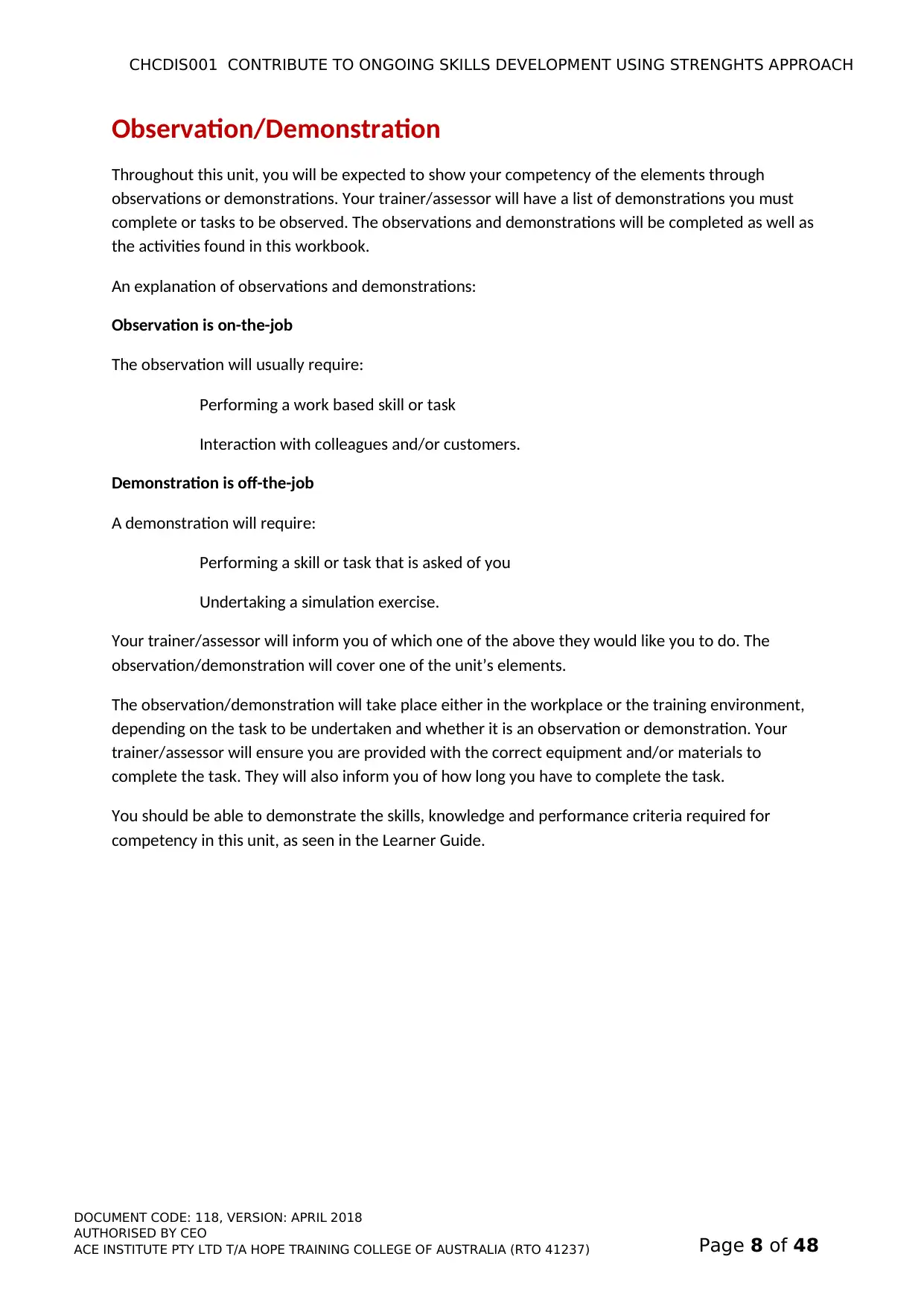
CHCDIS001 CONTRIBUTE TO ONGOING SKILLS DEVELOPMENT USING STRENGHTS APPROACH
Page 8 of 48
DOCUMENT CODE: 118, VERSION: APRIL 2018
AUTHORISED BY CEO
ACE INSTITUTE PTY LTD T/A HOPE TRAINING COLLEGE OF AUSTRALIA (RTO 41237)
Observation/Demonstration
Throughout this unit, you will be expected to show your competency of the elements through
observations or demonstrations. Your trainer/assessor will have a list of demonstrations you must
complete or tasks to be observed. The observations and demonstrations will be completed as well as
the activities found in this workbook.
An explanation of observations and demonstrations:
Observation is on-the-job
The observation will usually require:
Performing a work based skill or task
Interaction with colleagues and/or customers.
Demonstration is off-the-job
A demonstration will require:
Performing a skill or task that is asked of you
Undertaking a simulation exercise.
Your trainer/assessor will inform you of which one of the above they would like you to do. The
observation/demonstration will cover one of the unit’s elements.
The observation/demonstration will take place either in the workplace or the training environment,
depending on the task to be undertaken and whether it is an observation or demonstration. Your
trainer/assessor will ensure you are provided with the correct equipment and/or materials to
complete the task. They will also inform you of how long you have to complete the task.
You should be able to demonstrate the skills, knowledge and performance criteria required for
competency in this unit, as seen in the Learner Guide.
Page 8 of 48
DOCUMENT CODE: 118, VERSION: APRIL 2018
AUTHORISED BY CEO
ACE INSTITUTE PTY LTD T/A HOPE TRAINING COLLEGE OF AUSTRALIA (RTO 41237)
Observation/Demonstration
Throughout this unit, you will be expected to show your competency of the elements through
observations or demonstrations. Your trainer/assessor will have a list of demonstrations you must
complete or tasks to be observed. The observations and demonstrations will be completed as well as
the activities found in this workbook.
An explanation of observations and demonstrations:
Observation is on-the-job
The observation will usually require:
Performing a work based skill or task
Interaction with colleagues and/or customers.
Demonstration is off-the-job
A demonstration will require:
Performing a skill or task that is asked of you
Undertaking a simulation exercise.
Your trainer/assessor will inform you of which one of the above they would like you to do. The
observation/demonstration will cover one of the unit’s elements.
The observation/demonstration will take place either in the workplace or the training environment,
depending on the task to be undertaken and whether it is an observation or demonstration. Your
trainer/assessor will ensure you are provided with the correct equipment and/or materials to
complete the task. They will also inform you of how long you have to complete the task.
You should be able to demonstrate the skills, knowledge and performance criteria required for
competency in this unit, as seen in the Learner Guide.
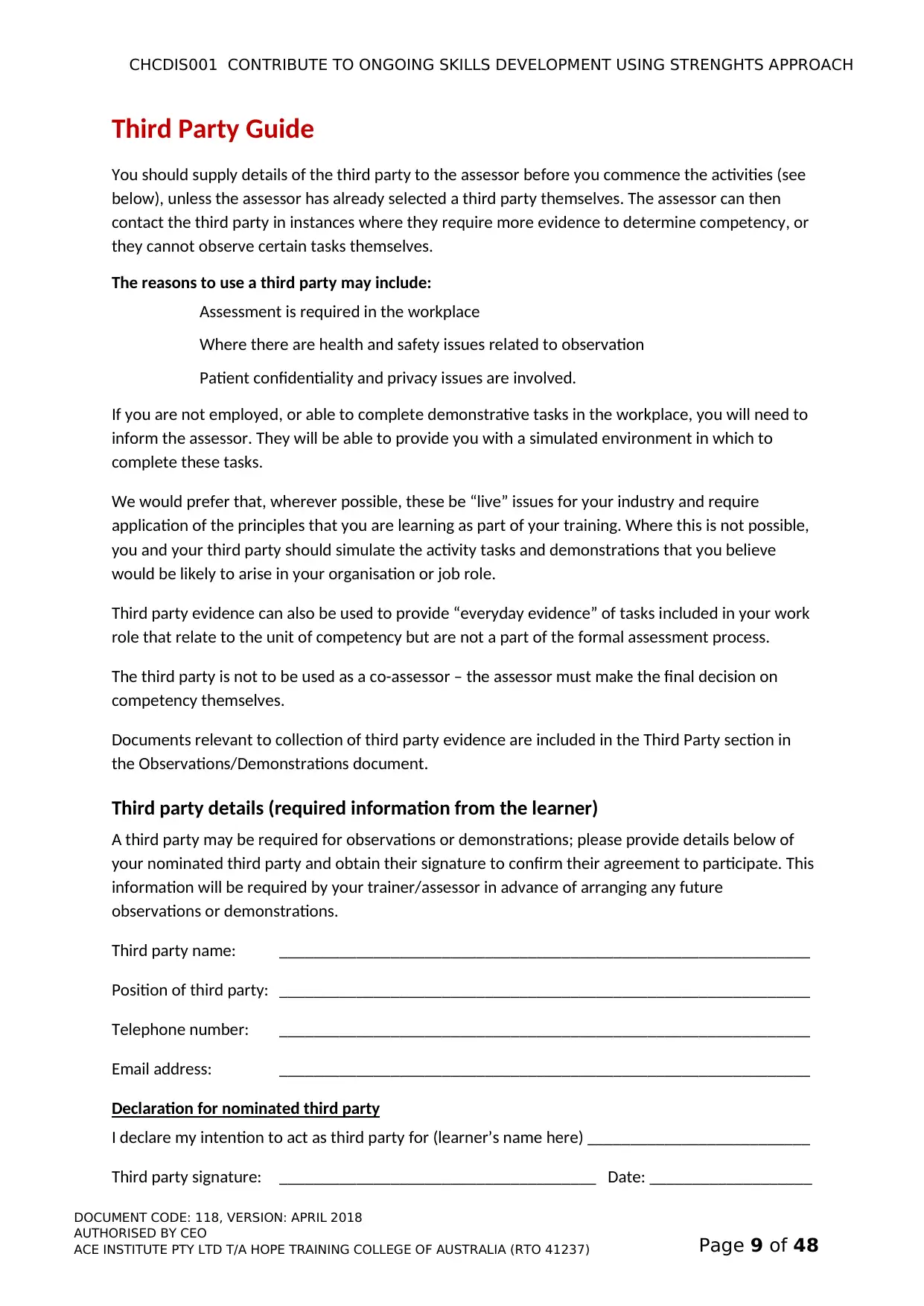
CHCDIS001 CONTRIBUTE TO ONGOING SKILLS DEVELOPMENT USING STRENGHTS APPROACH
Page 9 of 48
DOCUMENT CODE: 118, VERSION: APRIL 2018
AUTHORISED BY CEO
ACE INSTITUTE PTY LTD T/A HOPE TRAINING COLLEGE OF AUSTRALIA (RTO 41237)
Third Party Guide
You should supply details of the third party to the assessor before you commence the activities (see
below), unless the assessor has already selected a third party themselves. The assessor can then
contact the third party in instances where they require more evidence to determine competency, or
they cannot observe certain tasks themselves.
The reasons to use a third party may include:
Assessment is required in the workplace
Where there are health and safety issues related to observation
Patient confidentiality and privacy issues are involved.
If you are not employed, or able to complete demonstrative tasks in the workplace, you will need to
inform the assessor. They will be able to provide you with a simulated environment in which to
complete these tasks.
We would prefer that, wherever possible, these be “live” issues for your industry and require
application of the principles that you are learning as part of your training. Where this is not possible,
you and your third party should simulate the activity tasks and demonstrations that you believe
would be likely to arise in your organisation or job role.
Third party evidence can also be used to provide “everyday evidence” of tasks included in your work
role that relate to the unit of competency but are not a part of the formal assessment process.
The third party is not to be used as a co-assessor – the assessor must make the final decision on
competency themselves.
Documents relevant to collection of third party evidence are included in the Third Party section in
the Observations/Demonstrations document.
Third party details (required information from the learner)
A third party may be required for observations or demonstrations; please provide details below of
your nominated third party and obtain their signature to confirm their agreement to participate. This
information will be required by your trainer/assessor in advance of arranging any future
observations or demonstrations.
Third party name: ______________________________________________________________
Position of third party: ______________________________________________________________
Telephone number: ______________________________________________________________
Email address: ______________________________________________________________
Declaration for nominated third party
I declare my intention to act as third party for (learner’s name here) __________________________
Third party signature: _____________________________________ Date: ___________________
Page 9 of 48
DOCUMENT CODE: 118, VERSION: APRIL 2018
AUTHORISED BY CEO
ACE INSTITUTE PTY LTD T/A HOPE TRAINING COLLEGE OF AUSTRALIA (RTO 41237)
Third Party Guide
You should supply details of the third party to the assessor before you commence the activities (see
below), unless the assessor has already selected a third party themselves. The assessor can then
contact the third party in instances where they require more evidence to determine competency, or
they cannot observe certain tasks themselves.
The reasons to use a third party may include:
Assessment is required in the workplace
Where there are health and safety issues related to observation
Patient confidentiality and privacy issues are involved.
If you are not employed, or able to complete demonstrative tasks in the workplace, you will need to
inform the assessor. They will be able to provide you with a simulated environment in which to
complete these tasks.
We would prefer that, wherever possible, these be “live” issues for your industry and require
application of the principles that you are learning as part of your training. Where this is not possible,
you and your third party should simulate the activity tasks and demonstrations that you believe
would be likely to arise in your organisation or job role.
Third party evidence can also be used to provide “everyday evidence” of tasks included in your work
role that relate to the unit of competency but are not a part of the formal assessment process.
The third party is not to be used as a co-assessor – the assessor must make the final decision on
competency themselves.
Documents relevant to collection of third party evidence are included in the Third Party section in
the Observations/Demonstrations document.
Third party details (required information from the learner)
A third party may be required for observations or demonstrations; please provide details below of
your nominated third party and obtain their signature to confirm their agreement to participate. This
information will be required by your trainer/assessor in advance of arranging any future
observations or demonstrations.
Third party name: ______________________________________________________________
Position of third party: ______________________________________________________________
Telephone number: ______________________________________________________________
Email address: ______________________________________________________________
Declaration for nominated third party
I declare my intention to act as third party for (learner’s name here) __________________________
Third party signature: _____________________________________ Date: ___________________
⊘ This is a preview!⊘
Do you want full access?
Subscribe today to unlock all pages.

Trusted by 1+ million students worldwide
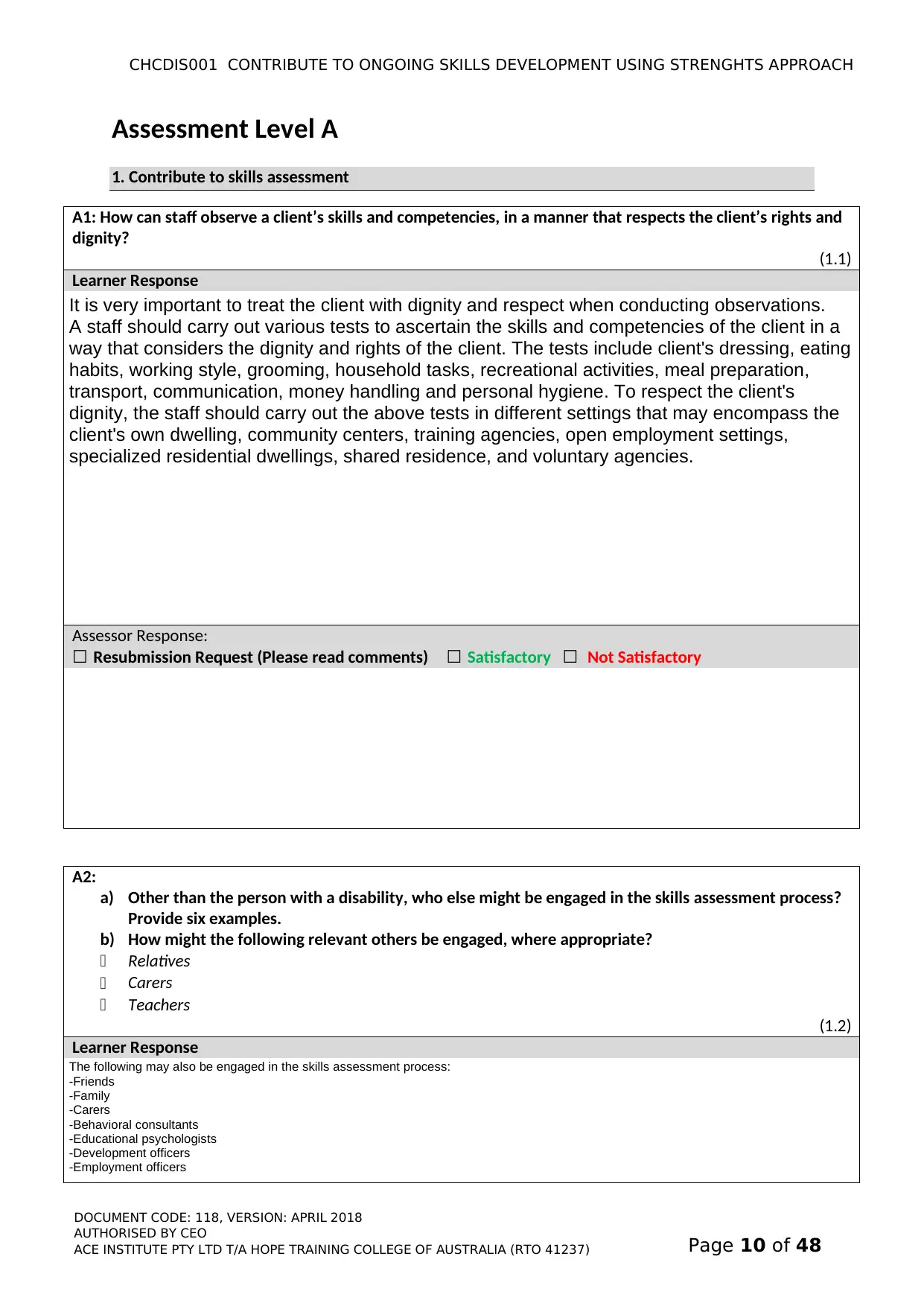
CHCDIS001 CONTRIBUTE TO ONGOING SKILLS DEVELOPMENT USING STRENGHTS APPROACH
Page 10 of 48
DOCUMENT CODE: 118, VERSION: APRIL 2018
AUTHORISED BY CEO
ACE INSTITUTE PTY LTD T/A HOPE TRAINING COLLEGE OF AUSTRALIA (RTO 41237)
Assessment Level A
1. Contribute to skills assessment
A1: How can staff observe a client’s skills and competencies, in a manner that respects the client’s rights and
dignity?
(1.1)
Learner Response
Assessor Response:
☐ ☐ Satisfactory ☐ Not SatisfactoryResubmission Request (Please read comments)
A2:
a) Other than the person with a disability, who else might be engaged in the skills assessment process?
Provide six examples.
b) How might the following relevant others be engaged, where appropriate?
Relatives
Carers
Teachers
(1.2)
Learner Response
It is very important to treat the client with dignity and respect when conducting observations.
A staff should carry out various tests to ascertain the skills and competencies of the client in a
way that considers the dignity and rights of the client. The tests include client's dressing, eating
habits, working style, grooming, household tasks, recreational activities, meal preparation,
transport, communication, money handling and personal hygiene. To respect the client's
dignity, the staff should carry out the above tests in different settings that may encompass the
client's own dwelling, community centers, training agencies, open employment settings,
specialized residential dwellings, shared residence, and voluntary agencies.
The following may also be engaged in the skills assessment process:
-Friends
-Family
-Carers
-Behavioral consultants
-Educational psychologists
-Development officers
-Employment officers
Page 10 of 48
DOCUMENT CODE: 118, VERSION: APRIL 2018
AUTHORISED BY CEO
ACE INSTITUTE PTY LTD T/A HOPE TRAINING COLLEGE OF AUSTRALIA (RTO 41237)
Assessment Level A
1. Contribute to skills assessment
A1: How can staff observe a client’s skills and competencies, in a manner that respects the client’s rights and
dignity?
(1.1)
Learner Response
Assessor Response:
☐ ☐ Satisfactory ☐ Not SatisfactoryResubmission Request (Please read comments)
A2:
a) Other than the person with a disability, who else might be engaged in the skills assessment process?
Provide six examples.
b) How might the following relevant others be engaged, where appropriate?
Relatives
Carers
Teachers
(1.2)
Learner Response
It is very important to treat the client with dignity and respect when conducting observations.
A staff should carry out various tests to ascertain the skills and competencies of the client in a
way that considers the dignity and rights of the client. The tests include client's dressing, eating
habits, working style, grooming, household tasks, recreational activities, meal preparation,
transport, communication, money handling and personal hygiene. To respect the client's
dignity, the staff should carry out the above tests in different settings that may encompass the
client's own dwelling, community centers, training agencies, open employment settings,
specialized residential dwellings, shared residence, and voluntary agencies.
The following may also be engaged in the skills assessment process:
-Friends
-Family
-Carers
-Behavioral consultants
-Educational psychologists
-Development officers
-Employment officers
Paraphrase This Document
Need a fresh take? Get an instant paraphrase of this document with our AI Paraphraser
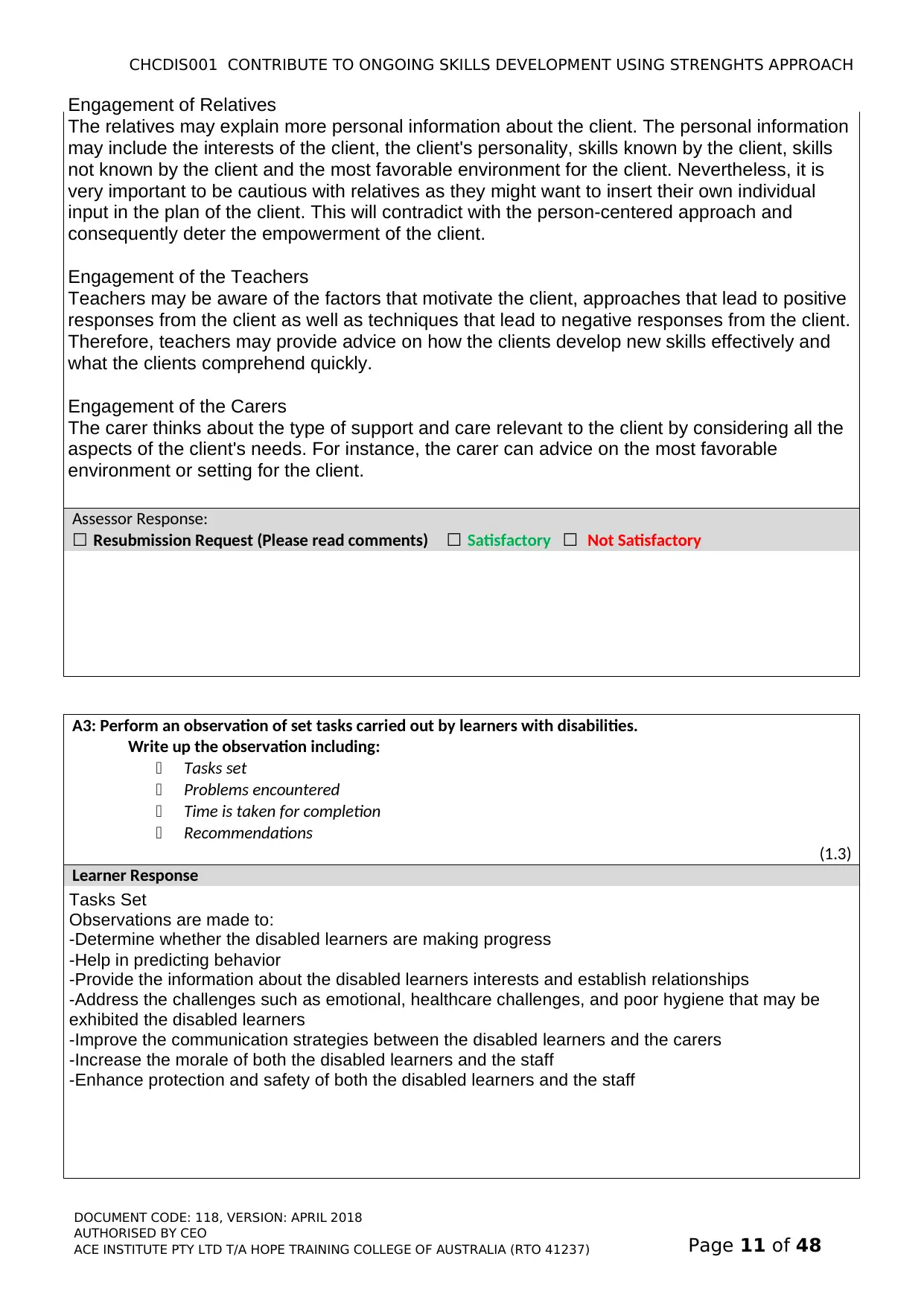
CHCDIS001 CONTRIBUTE TO ONGOING SKILLS DEVELOPMENT USING STRENGHTS APPROACH
Page 11 of 48
DOCUMENT CODE: 118, VERSION: APRIL 2018
AUTHORISED BY CEO
ACE INSTITUTE PTY LTD T/A HOPE TRAINING COLLEGE OF AUSTRALIA (RTO 41237)
Assessor Response:
☐ ☐ Satisfactory ☐ Not SatisfactoryResubmission Request (Please read comments)
A3: Perform an observation of set tasks carried out by learners with disabilities.
Write up the observation including:
Tasks set
Problems encountered
Time is taken for completion
Recommendations
(1.3)
Learner Response
Tasks Set
Observations are made to:
-Determine whether the disabled learners are making progress
-Help in predicting behavior
-Provide the information about the disabled learners interests and establish relationships
-Address the challenges such as emotional, healthcare challenges, and poor hygiene that may be
exhibited the disabled learners
-Improve the communication strategies between the disabled learners and the carers
-Increase the morale of both the disabled learners and the staff
-Enhance protection and safety of both the disabled learners and the staff
Engagement of Relatives
The relatives may explain more personal information about the client. The personal information
may include the interests of the client, the client's personality, skills known by the client, skills
not known by the client and the most favorable environment for the client. Nevertheless, it is
very important to be cautious with relatives as they might want to insert their own individual
input in the plan of the client. This will contradict with the person-centered approach and
consequently deter the empowerment of the client.
Engagement of the Teachers
Teachers may be aware of the factors that motivate the client, approaches that lead to positive
responses from the client as well as techniques that lead to negative responses from the client.
Therefore, teachers may provide advice on how the clients develop new skills effectively and
what the clients comprehend quickly.
Engagement of the Carers
The carer thinks about the type of support and care relevant to the client by considering all the
aspects of the client's needs. For instance, the carer can advice on the most favorable
environment or setting for the client.
Page 11 of 48
DOCUMENT CODE: 118, VERSION: APRIL 2018
AUTHORISED BY CEO
ACE INSTITUTE PTY LTD T/A HOPE TRAINING COLLEGE OF AUSTRALIA (RTO 41237)
Assessor Response:
☐ ☐ Satisfactory ☐ Not SatisfactoryResubmission Request (Please read comments)
A3: Perform an observation of set tasks carried out by learners with disabilities.
Write up the observation including:
Tasks set
Problems encountered
Time is taken for completion
Recommendations
(1.3)
Learner Response
Tasks Set
Observations are made to:
-Determine whether the disabled learners are making progress
-Help in predicting behavior
-Provide the information about the disabled learners interests and establish relationships
-Address the challenges such as emotional, healthcare challenges, and poor hygiene that may be
exhibited the disabled learners
-Improve the communication strategies between the disabled learners and the carers
-Increase the morale of both the disabled learners and the staff
-Enhance protection and safety of both the disabled learners and the staff
Engagement of Relatives
The relatives may explain more personal information about the client. The personal information
may include the interests of the client, the client's personality, skills known by the client, skills
not known by the client and the most favorable environment for the client. Nevertheless, it is
very important to be cautious with relatives as they might want to insert their own individual
input in the plan of the client. This will contradict with the person-centered approach and
consequently deter the empowerment of the client.
Engagement of the Teachers
Teachers may be aware of the factors that motivate the client, approaches that lead to positive
responses from the client as well as techniques that lead to negative responses from the client.
Therefore, teachers may provide advice on how the clients develop new skills effectively and
what the clients comprehend quickly.
Engagement of the Carers
The carer thinks about the type of support and care relevant to the client by considering all the
aspects of the client's needs. For instance, the carer can advice on the most favorable
environment or setting for the client.
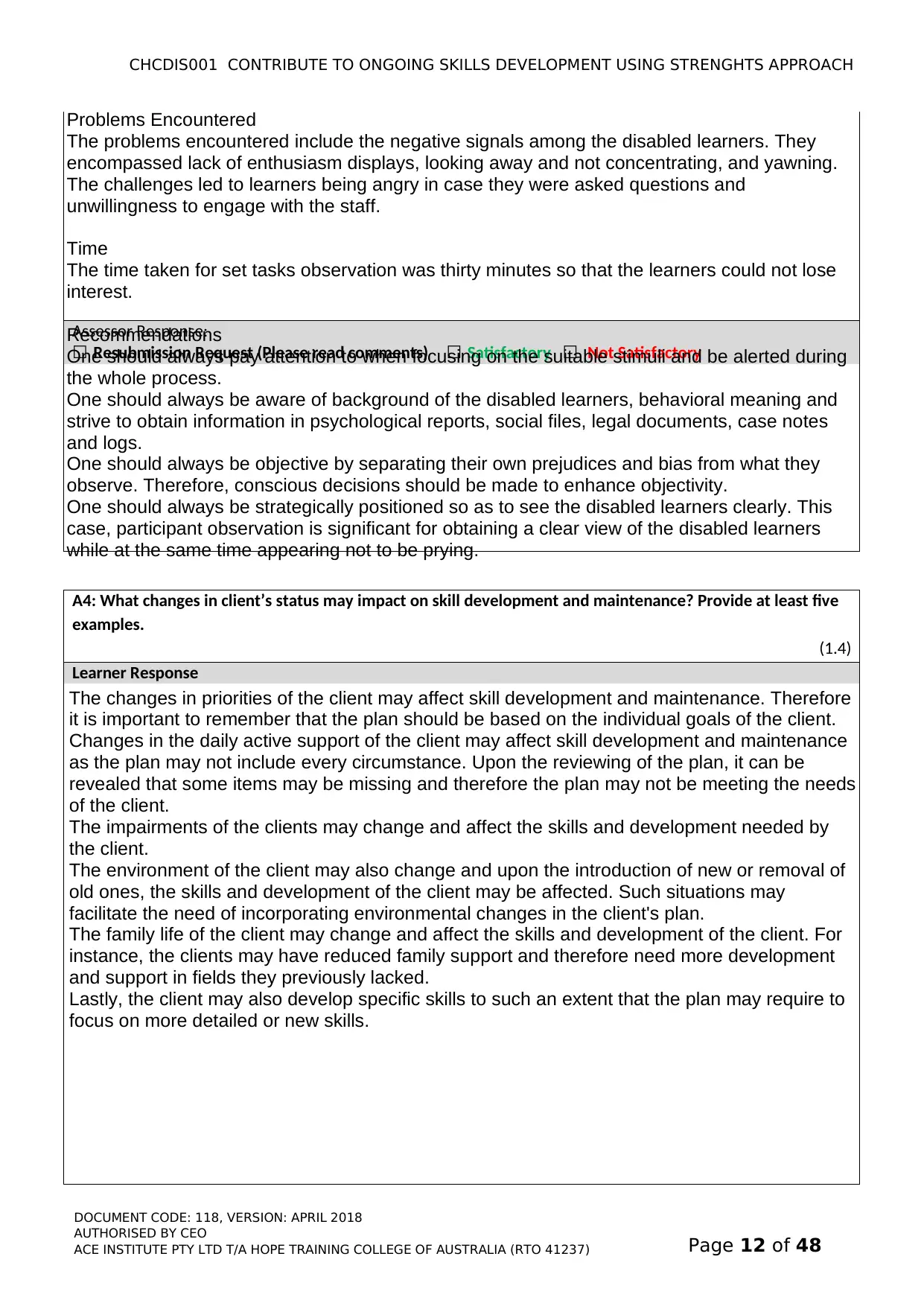
CHCDIS001 CONTRIBUTE TO ONGOING SKILLS DEVELOPMENT USING STRENGHTS APPROACH
Page 12 of 48
DOCUMENT CODE: 118, VERSION: APRIL 2018
AUTHORISED BY CEO
ACE INSTITUTE PTY LTD T/A HOPE TRAINING COLLEGE OF AUSTRALIA (RTO 41237)
Assessor Response:
☐ ☐ Satisfactory ☐ Not SatisfactoryResubmission Request (Please read comments)
A4: What changes in client’s status may impact on skill development and maintenance? Provide at least five
examples.
(1.4)
Learner Response
The changes in priorities of the client may affect skill development and maintenance. Therefore
it is important to remember that the plan should be based on the individual goals of the client.
Changes in the daily active support of the client may affect skill development and maintenance
as the plan may not include every circumstance. Upon the reviewing of the plan, it can be
revealed that some items may be missing and therefore the plan may not be meeting the needs
of the client.
The impairments of the clients may change and affect the skills and development needed by
the client.
The environment of the client may also change and upon the introduction of new or removal of
old ones, the skills and development of the client may be affected. Such situations may
facilitate the need of incorporating environmental changes in the client's plan.
The family life of the client may change and affect the skills and development of the client. For
instance, the clients may have reduced family support and therefore need more development
and support in fields they previously lacked.
Lastly, the client may also develop specific skills to such an extent that the plan may require to
focus on more detailed or new skills.
Problems Encountered
The problems encountered include the negative signals among the disabled learners. They
encompassed lack of enthusiasm displays, looking away and not concentrating, and yawning.
The challenges led to learners being angry in case they were asked questions and
unwillingness to engage with the staff.
Time
The time taken for set tasks observation was thirty minutes so that the learners could not lose
interest.
Recommendations
One should always pay attention to when focusing on the suitable stimuli and be alerted during
the whole process.
One should always be aware of background of the disabled learners, behavioral meaning and
strive to obtain information in psychological reports, social files, legal documents, case notes
and logs.
One should always be objective by separating their own prejudices and bias from what they
observe. Therefore, conscious decisions should be made to enhance objectivity.
One should always be strategically positioned so as to see the disabled learners clearly. This
case, participant observation is significant for obtaining a clear view of the disabled learners
while at the same time appearing not to be prying.
Page 12 of 48
DOCUMENT CODE: 118, VERSION: APRIL 2018
AUTHORISED BY CEO
ACE INSTITUTE PTY LTD T/A HOPE TRAINING COLLEGE OF AUSTRALIA (RTO 41237)
Assessor Response:
☐ ☐ Satisfactory ☐ Not SatisfactoryResubmission Request (Please read comments)
A4: What changes in client’s status may impact on skill development and maintenance? Provide at least five
examples.
(1.4)
Learner Response
The changes in priorities of the client may affect skill development and maintenance. Therefore
it is important to remember that the plan should be based on the individual goals of the client.
Changes in the daily active support of the client may affect skill development and maintenance
as the plan may not include every circumstance. Upon the reviewing of the plan, it can be
revealed that some items may be missing and therefore the plan may not be meeting the needs
of the client.
The impairments of the clients may change and affect the skills and development needed by
the client.
The environment of the client may also change and upon the introduction of new or removal of
old ones, the skills and development of the client may be affected. Such situations may
facilitate the need of incorporating environmental changes in the client's plan.
The family life of the client may change and affect the skills and development of the client. For
instance, the clients may have reduced family support and therefore need more development
and support in fields they previously lacked.
Lastly, the client may also develop specific skills to such an extent that the plan may require to
focus on more detailed or new skills.
Problems Encountered
The problems encountered include the negative signals among the disabled learners. They
encompassed lack of enthusiasm displays, looking away and not concentrating, and yawning.
The challenges led to learners being angry in case they were asked questions and
unwillingness to engage with the staff.
Time
The time taken for set tasks observation was thirty minutes so that the learners could not lose
interest.
Recommendations
One should always pay attention to when focusing on the suitable stimuli and be alerted during
the whole process.
One should always be aware of background of the disabled learners, behavioral meaning and
strive to obtain information in psychological reports, social files, legal documents, case notes
and logs.
One should always be objective by separating their own prejudices and bias from what they
observe. Therefore, conscious decisions should be made to enhance objectivity.
One should always be strategically positioned so as to see the disabled learners clearly. This
case, participant observation is significant for obtaining a clear view of the disabled learners
while at the same time appearing not to be prying.
⊘ This is a preview!⊘
Do you want full access?
Subscribe today to unlock all pages.

Trusted by 1+ million students worldwide
1 out of 48
Related Documents
Your All-in-One AI-Powered Toolkit for Academic Success.
+13062052269
info@desklib.com
Available 24*7 on WhatsApp / Email
![[object Object]](/_next/static/media/star-bottom.7253800d.svg)
Unlock your academic potential
Copyright © 2020–2025 A2Z Services. All Rights Reserved. Developed and managed by ZUCOL.




